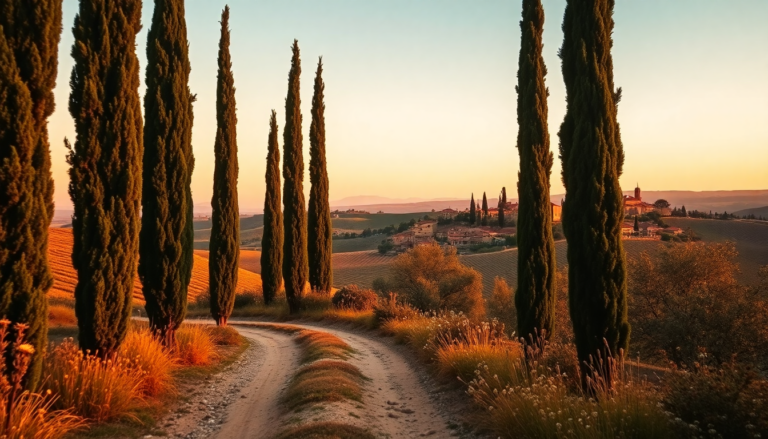Argomenti trattati
The San Jacopo Trail is not just a path; it’s a vibrant tapestry woven from the threads of history, culture, and the serene beauty of Tuscany. Imagine walking through picturesque landscapes, where every step reveals charming medieval towns and lush hillsides whispering stories of centuries past. This approximately 170-kilometer trail connects Florence to Livorno, drawing its inspiration from the ancient pilgrimage routes leading to Santiago de Compostela. As I set foot on this trail, I remember the first time I felt that perfect blend of spirituality and adventure—there’s something magical about walking in the footsteps of those who came before us.
A rich historical background
The roots of the San Jacopo Trail stretch back to the Middle Ages when pilgrims traversed Europe towards the sacred shrines of Christianity. Among these was the revered Santiago de Compostela, but not everyone could manage that journey. Some found solace in Pistoia, a town that received a relic of St. James, which cemented its role as a significant stop on the pilgrimage circuit. This transformation of Pistoia into a “minor Compostela” marked the beginning of a spiritual path that continues to resonate today.
Now, this trail serves a dual purpose. It invites modern pilgrims to reconnect with their spiritual selves while also embracing the cultural and historical narratives of Tuscany. Walking the San Jacopo Trail is like taking a step back in time—each village, each hill, each vista tells a story. It’s a journey that combines devotion with discovery, allowing travelers to experience a Tuscany that is often overlooked.
From Florence to Livorno: The six main stages
The San Jacopo Trail is divided into six main stages, each offering its own unique experiences and challenges. Starting from Florence, the journey meanders through Prato, Pistoia, Pescia, Lucca, and Pisa, before finally reaching Livorno. The beauty of this trail lies in its variety; you’ll encounter urban landscapes, rolling hills, and serene flatlands, all while absorbing the rich tapestry of history, art, and spirituality.
Setting off from Florence, the first leg takes you through gentle hills and historical villas, all while weaving through the countryside that inspired countless artists. Once you pass the metropolitan area, you’ll find yourself in Prato, where the majestic Cathedral of Santo Stefano and the well-preserved historic center await your exploration. It’s a relatively easy start—perfect for those new to hiking.
Challenges and rewards along the way
The second stage presents a bit more of a challenge, with moderate elevation gains as you head towards Pistoia. This town is a spiritual hub of the trail, housing the relic of St. James in the Cathedral of San Zeno. Here, the path wanders through charming medieval villages, offering breathtaking panoramic views and moments of tranquility in nature. Personally, I found this segment to be a highlight; there’s something profound about walking in a place where history lingers in the air.
Continuing, the longest stretch takes you through the beautiful Valdinievole, dotted with olive groves and quaint villages like Collodi, known for its enchanting Pinocchio Park. As you approach Pescia, the authentic essence of Tuscany shines through, with its historical significance in floriculture and artisanal traditions. It’s wise to start early on this day—it’s a longer trek, but the sights are worth every step.
Traversing iconic landscapes
The next stage leads you to Lucca, where the landscape flattens out, allowing you to traverse the lush countryside and explore historic towns like San Gennaro. Arriving in Lucca is quite the spectacle; entering through the city’s renowned Renaissance walls feels like stepping into a different era. You can visit the Cathedral of San Martino and the Church of San Michele in Foro, both of which are rich in art and history.
As the trail continues, it partially follows the ancient Via Francigena towards Pisa. The sight of the Piazza dei Miracoli, with its iconic Leaning Tower, is an emotional culmination of the journey. Can you imagine the thrill of finally reaching this landmark after days of walking?
The final leg to Livorno
The final stretch to Livorno is both diverse and stimulating, often requiring you to split it into two parts. After departing from Pisa, you’ll traverse coastal areas and protected natural environments typical of Northern Maremma. Reaching Livorno, particularly the Church of San Jacopo in Acquaviva, symbolizes the culmination of your pilgrimage—a beautiful intersection of land and sea, history and spirituality.
Practical tips for your journey
One of the remarkable aspects of the San Jacopo Trail is its accessibility. With well-distributed accommodations and clear signage, you can navigate this path even without a GPS. Carrying a detailed map or using a tracking app is advisable, though. The trail is predominantly on paved or well-trodden paths, so lightweight hiking shoes or urban walking boots are recommended. Trekking poles can be helpful on the hilly sections, especially between Pistoia and Pescia.
It’s important to consider the heat during the summer months; starting early in the morning and bringing at least 1.5 liters of water along with energy snacks is essential. The trail can be customized to fit your schedule, allowing you to embark on just a portion if you prefer, thanks to the frequent train connections between stages.
The best times to walk the trail
The ideal months to tackle the San Jacopo Trail are from April to June and September to October when the weather is mild and the days are long enough for leisurely walks. Summer can be quite taxing due to high temperatures, while winter might present challenges in the hilly areas due to rain or mud. However, it’s important to note that the trail is traversable year-round.
This journey caters to those seeking a meditative yet accessible experience, blending culture, nature, and spirituality in a well-organized context. It’s perfect for those not keen on tackling steep mountain paths yet still yearning for the adventure of the trail. Whether you’re with friends or going solo, the San Jacopo Trail offers an authentic way to rediscover Tuscany.

